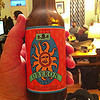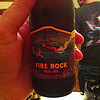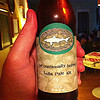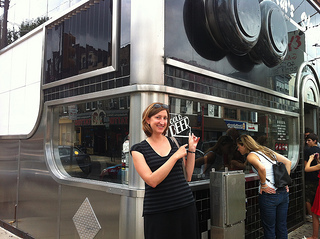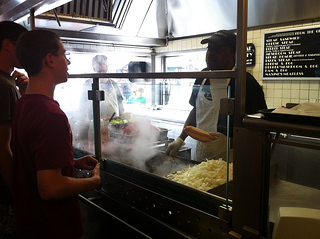Jeremy Keith's Blog, page 125
August 18, 2013
August in America, day fifteen
Being a beachy surfer kind of place, it made sense that we spent our last day in San Diego hanging out by the beach. We went to La Jolla. We watched people swim, snorkel, and paddle-board. In amongst the human activity, we also saw the occasional seal pop its head out of the water.
It was another beautiful day in San Diego. It was also my last day in San Diego: tomorrow I head north to San Francisco.
I was all set for another flight until disastrously my Kindle gave up the ghost. The e-ink display is b0rked, permanently showing half of Jane Austen and half of a New Aesthetic glitch. So on the way to dinner at the Stone Brewery this evening, we stopped off at a Best Buy so I could slap down some money to buy a bog-standard non-touch, non-white Kindle.
Imagine my disgust when I get it home, charged it up, connected it to a WiFi network, registered it, and discovered that it comes encumbered with advertising that can’t be switched off (the Amazon instructions for unsubscribing from these “special offers”—by paying to do so—don’t work if your device is registered with a UK Amazon account).
A little bit of Googling revealed that the advertising infestation resides in a hidden folder named /system/.assets. If you replace this folder with an empty file (and keep WiFi switched off by having your Kindle in airplane mode), then the advertising is cast out.
So connect your Kindle—that you bought, with your money—to your Mac, open up the Terminal and type:
cd /Volumes/Kindle/system
rm -r .assets
touch .assets
Now I can continue to read The Shining Girls in peace on my flight to San Francisco tomorrow.
Tagged with
americanaugust
sandiego
kindle
advertising
hacking
reading
August 17, 2013
August in America, day fourteen
I remember the first time I was in San Diego in 2008, a bunch of us were hanging out at the Lamplighter, a dive bar that was the scene of my first traumatic karaoke experience. Ted and Erin were extolling the virtues of San Diego. They described it as having all the good aspects of Los Angeles but without the craziness. True enough, San Diego is a pretty laid back place.
Today was a laid back kinda day. Jessica, Jeb and I were in full tourist mode, wandering around the seafront and revisiting the USS Midway. What can I say? I like airplanes. And ships.
We ended the day at a pizza place that I’m pretty sure I’ve been to before. That would’ve been the last time I was in San Diego, which was Halloween 2010. Once again, I met up with Ted and Erin except that this time they were in fancy dress; Scott Pilgrim fancy dress to be precise. Erin cut an impressive figure as Ramona, while Ted came as “Mark Pilgrim as Scott Pilgrim” …possibly the meta-geekiest thing ever.
That was before Ted and Erin up sticks and moved to San Francisco. Coincidentally, San Francisco will be the next stop on my trip so here’s hoping I see them there.
Tagged with
americanaugust
sandiego
california
August 16, 2013
August in America, day thirteen
I’ve been to San Diego twice before. The first time was in 2008 for one of Jared’s conferences that took place on Coronado. The second time was two years later for An Event Apart in 2010. That time I was staying downtime.
This time I’m staying with Jeb in Ocean Beach. I like it here. It’s got a very laid-back feel. People walk down the street with surfboards under their arms. Or else they skate down the street. Probably on their way to get fish tacos. Exceptionally good fish tacos.
As the name suggests, there is a beach here. More importantly, there is a dog beach. A dog beach! A beach where dogs of all shapes and sizes can run free, cavort in the surf and sniff one another’s butts.
I like dog-watching and everyone here has a dog. I particularly like hanging out with these two mutts: Lola and Mesa.
Like almost everywhere in San Diego, Ocean Beach lies under a flight path—a natural consequence of having your airport right downtown. Jeb told us about “The OB Pause”. That’s when you’re in the middle of a conversation and you pause…
vrrrroooOOOOOOOOoooooommmmm
…and then continue right where left off once the jet has left your airspace.
Tagged with
americanaugust
sandiego
oceanbeach
california
August 14, 2013
August in America, day twelve
Today was a travel day, but it was a short travel day: the flight from Tucson to San Diego takes just an hour. It took longer to make the drive up from Sierra Vista to Tucson airport.
And what a lovely little airport it is. When we showed up, we were literally the only people checking in and the only people going through security. After security is a calm oasis, free of the distracting TV screens that plague most other airports. Also, it has free WiFi, which was most welcome. I’m relying on WiFi, not 3G, to go online on this trip.
I’ve got my iPhone with me but I didn’t do anything to guarantee myself a good data plan while I’m here in the States. Honestly, it’s not that hard to not always be connected to the internet. Here are a few things I’ve learned along the way:
To avoid accidentally using data and getting charged through the nose for it, you can go into the settings of your iPhone and under General -> Cellular, you can switch “Cellular Data” to “off”. Like it says, “Turn off cellular data to restrict all data to Wi-Fi, including email, web browsing, and push notifications.”
If you do that, and you normally use iMessage, make sure to switch iMessage off. Otherwise if someone with an iPhone in the States sends you an SMS, you won’t get it until the next time you connect to a WiFi network. I learned this the hard way: it happened to me twice on this trip before I realised what was going on.
I use Google Maps rather than Apple Maps. It turns out you can get offline maps on iOS (something that’s been available on Android for quite some time). Open the Google Maps app while you’re still connected to a WiFi network; navigate so that the area you want to save is on the screen; type “ok maps” into the search bar; now that map is saved and zoomable for offline browsing.
August 13, 2013
August in America, day eleven
Sierra Vista is located just a few miles to north of Mexico. If you’re driving up to Benson or Tucson, you can expect to be stopped by the border police. Please have your papers ready for inspection.
Most days, a tethered unmanned blimp hovers over the mountains to the south of Sierra Vista. On some nights, you can see the light of a drone traversing the air above the border.
Sierra Vista is also home to an army base, hence the occasional helicopters and aircraft.
Tomorrow we leave for San Diego, right next to the border with Tijuana.
Tagged with
americanaugust
arizona
border
sierravista
August in America, day ten
Today was another sunny day in Arizona.
I saw a snake; it had a rattle. I admired prickly pear cacti, and when I picked up a prickly pear that had fallen to the ground, I discovered exactly why it’s called a prickly pear.
But I spent much of this sunny Arizona day in the dark.
We went to Kartchner Caverns, a series of limestone caves fifty mega-years old. It was quite beautiful.
The caverns might be ancient, but the state park is relatively young. The caves were first discovered in 1974. The story of what happened next is quite fascinating. The cavers who discovered the caverns teamed up with the landowner to negotiate with the State about creating a publicly-accessible state park (negotiations that had to happen in secret so that the caverns wouldn’t be despoiled if word got out).
They had come to the conclusion that the best chance of preserving the caverns was not to keep them secret, but to make them public under appropriate stewardship. It reminded me of the mantra of the Internet Archive:
Access drives preservation.
Tagged with
americanaugust
arizona
kartchner
caverns
preservation
August 12, 2013
August in America, day nine
Today was a day of rest. And in Arizona, that means lounging in or near the swimming pool.
Thanks to recently-installed solar panels on the roof, the water was nice and warm. Jessica did laps of the pool, while I splashed around spasmodically. Y’see, I can’t actually swim. Yes, I grew up by the sea, but you have to understand; that sea was bloody freezing.
So now I’m trying to figure out this whole swimming thing from first principles, but I’m not sure my brain has enough plasticity left to grasp the coordination involved. Still, it’s fun to attempt to swim, no matter how quixotic the goal.
It’s monsoon season in southern Arizona right now, meaning it’s almost certain to rain sometime in the afternoon. That’s why we got our swimming activities done early. Sure enough, thunder clouds started rolling in, but there wasn’t much rain in the end.
Fortunately the clouds had mostly dissipated by the time the sun went down, so a few hours later, when we went outside to look up and search the starry sky for the Perseids, we got to see a few pieces of Swift-Tuttle streaking across the firmament.
August 11, 2013
August in America, day eight
Today was a travel day. It was time to leave our most excellent hosts in Philadelphia and make our way to Jessica’s parents in Sierra Vista, Arizona.
I spent most of the travel time with my headphones on, listening to music and reading on my Kindle. I finished Kim Stanley Robinson’s 2312, a thoroughly enjoyable—if not exactly tightly-plotted—romp around the solar system, and started in on Lauren’s latest, The Shining Girls. It’s a real page-turner. Or, in the case of the Kindle, a real button-pusher.
For take-off and landing, headphones and Kindles have to be stowed so I always make sure I’ve got a good ol’ dead-tree tome with me on any plane journey. On this occasion I started into a copy Rainbows End by Vernor Vinge that I picked up at a second-hand bookstore in Alexandria earlier this week.
There was no direct way to get from Philadelphia to Tucson, the nearest airport to Sierra Vista. Layovers were inevitable. We flew with Delta, which meant that our layover would be at their hub in Atlanta.
The flight from Philly to Atlanta was pretty straightforward, but we could see storm clouds brewing. After a stopover in Atlanta for a couple of hours, we continued on to Tucson, by which time the storm clouds were brewed and angry.
As we chased the sunset, we flew over a landscape of explosions in the sky. Dark cloudscapes erupted with light every minute or so. It looked like a bombardment of multiple timezones. At one point, Jessica saw a shooting star. It was as if the Perseids were MIRVing to deliver angry payloads of light flashes while we flew unscathed above it all.
Tagged with
americanaugust
travel
reading
sci-fi
sciencefiction
flying
arizona
August 9, 2013
August in America, day seven
Today was another day of excellent perambulations around Philadelphia. This time Jessica and I went to the Italian market featured so heavily in Rocky. Then we wandered up to Reading Terminal Market and took in the tastes and smells. Who knew the Amish made such good doughnuts?
But the main event of this day, this week, and indeed, this month, was the PPC: Philly Pizza Club. This involves the consumption of pizza and many varieties of beer.
The beer was necessary because the other the portion of PPC is the entertainment. And I use the term loosely. This evening’s “entertainment” was the classic 1987 film Miami Connection.
It was the best crossover ’80s rock ninja movie I’ve ever seen.
Tagged with
americanaugust
philadelphia
beer
pizza
movie
August 8, 2013
August in America, day six
Jessica and I spent today in full-on tourist mode in Philadelphia, walking its streets and exploring its rich heritage.
Philadelphia, home to the Liberty Bell and the American constitution; the city where the founding fathers toiled at their work, forging a revolution and a country; home to the country’s first library and its first bank; in many ways, the birthplace of the modern world.
Yeah, yeah, yeah. Whatever. Here’s the important part: today I had my first ever Philly cheesesteak.
Every Philadelphian has a very strong opinion about where the best cheesesteak in the city is to be had, and we went with a highly-recommended, very popular spot: Jim’s. There was a line out the door. This is a daily occurrence.
When you eventually get to the point of ordering, you are strongly encouraged to quickly and clearly state your cheese choice and onion preference (a Boolean value). Then you pay. Then you find a seat, if you’re lucky. Then you eat.
On the recommendation of the internet, I went with the cheese wiz option. Technically, I’m not even sure if it’s actually a cheese. But boy, it sure works a treat in combination with the delicious beef and onions. The cheese wiz acted as a mayonnaise-like lubricant as well as a flavour ingredient. All in all, it was absolutely superb. If all cheesesteaks are this good, I can understand this city’s pride in—and obsession with—its contribution to the sandwich world.
After that we wandered around and took in the sights until it was time to meet up with Jenn and Sutter for a beer at sunset while watching an infinite supply of joggers run up the Rocky steps and raise their arms in the air at the summit.
Tagged with
americanaugust
philadelphia
cheesesteak
food
Jeremy Keith's Blog
- Jeremy Keith's profile
- 56 followers











